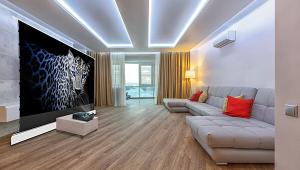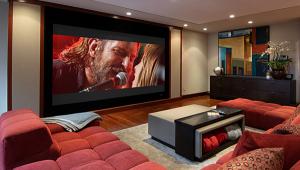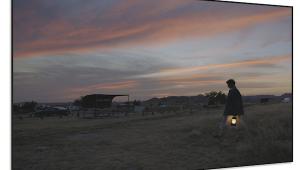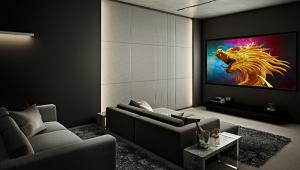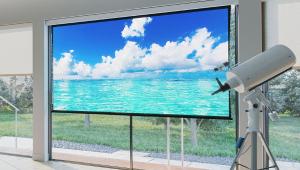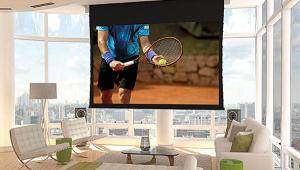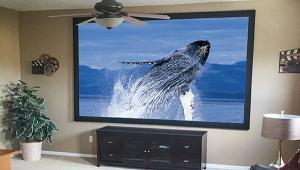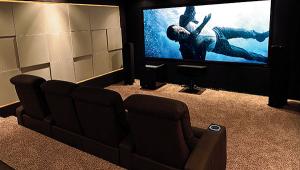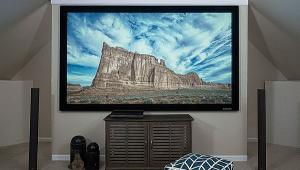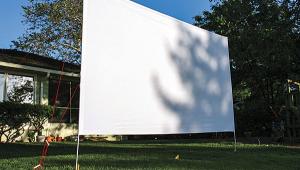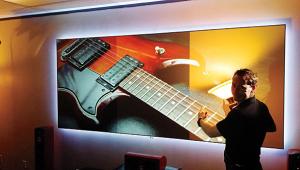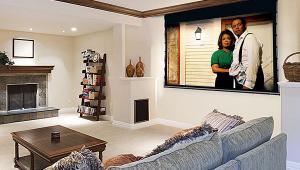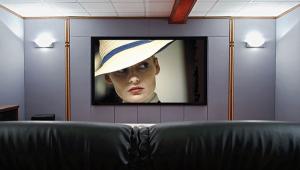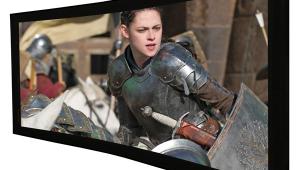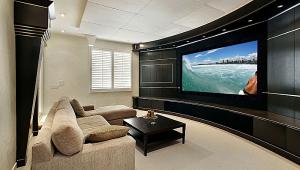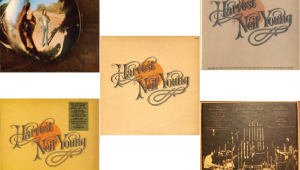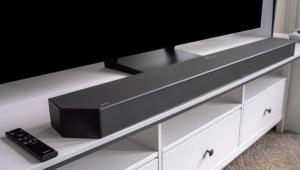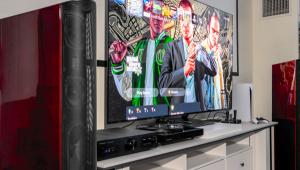Quick Take: Elite ezCinema Tab-Tension CineGrey 4D Screen & Anker Nebula Mars 3 Projector

 (5).JPG)
Regarding portable entertainment, you can do much with a phone or tablet, a projector, and this Elite screen. If you are having a party, you should project music videos. That makes this projector special; wherever you are, it’s got you covered for having a good time.
The Elite screen comes in two sizes: 113" ($939) and 121" ($1,039) measured diagonally, both in a 16:9 aspect ratio. 8" is not a huge difference, but I used the 121" version of the screen. I have a 98" TV, and I must admit, a 121" screen does not look as huge as it used to back when 85-inch TVs were considered an extravagance. The screen offers a 1.1 gain and ceiling light rejection and is designed for long-throw projectors and not USTs (or even regular short-throw models; you’ll lose a lot of light output if you try). Elite says the CineGray 4D screen rejects 63% of ambient light.
Easy Does it
The screen’s deployment mechanism is fully manual; the case rests on the floor, and you extend a rod to the chosen length to hold up the extendable, masked, and tensioned screen. It is remarkably light and easy, creating an impressive “on-the-spot” cinematic display.
 (1).jpg)
Please note that this Elite screen is not an outdoor screen. Nevertheless, it can be used outside temporarily if it is not windy and wet. This is because the screen material is relatively delicate and the stand is not designed to withstand the wind. It is for use in spaces that have little or no light control. The upshot is that the tab tensioning and the supple screen material work together to create a flat projection surface. The material is opaque; backlighting does not affect it at all.
A Perfect Match
The Mars 3 is an excellent companion for this screen, leveraging the 1.1 gain to deliver a surprisingly bright and crisp image. It’s rated at 1000 ANSI lumens, enough to “get the job done” with a 121", 1.1-gain screen (85 nits peak). The resolution is 1080p, but it accepts 4K input up to 60 Hz (including HDR10) and uses LED-lit DLP technology plus a fixed lens, so it makes the most of its pixels. Audio reproduction from the projector is robust, up to 40W of output is on tap, and I never heard any fan noise. It’s also water and dust-resistant (IPX3 rating) and carries a 0.5m drop rating as well. I love that there is a protective door for the lens, which acts as the power switch.
The key feature combo on the Mars 3 is its 185-Wh battery and wireless connectivity. With Chromecast built-in and Android TV 11.0, you—and anyone with a phone, tablet, or laptop—can easily stream movies, shows, games, photos, videos, AI art, etc. Screen mirroring adds additional ease and flexibility.
It’s even possible for one person to carry both the screen and the projector, at least for a short distance. With two people, you can take this portable theater anywhere you can fit the rolled-up screen.
Setup takes only a few minutes, one or two for the screen and a few more to get the projector perched and powered up. The Mars 3 automatically handles focus, keystone correction, and fit from there. However, I found matching the image to the screen by hand satisfying since it preserves the highest quality. Still, the automatic process sure is fast and convenient in a pinch! Since this is not a 4K projector, I don’t want to give up any resolution I don’t have to. It takes a few extra minutes because you have to move the projector to get things just right manually.
I tried the screen in my loft living room, which has a 13-foot ceiling, huge windows, is painted white, and is large enough for a screen like this. The result may not compete with the latest lifestyle or home theater projectors (that cost a lot more), but it is a credible projector for the living room, given the price and potential applications. The brightness was impressive, and I saw no egregious anomalies that distracted me from the experience. I would not substitute this screen for a permanent installation, but that’s not what it’s designed for!
Streaming Philadelphia 76ers games in full HD through YouTube TV looked great, the 1.1 gain ensuring that even a cloudy Sunday afternoon game was clear and easily visible. I would not watch a movie under those conditions, but sports worked out great.
After sunset, I took the screen outside to the rooftop deck of my urban loft apartment building. It is as good a torture test as any of the projector and Screen combination can do because there’s abundant light pollution. Inside the building is a gym and swimming pool with all-glass walls and extremely bright light. Behind the screen is the city of Philly and a bright sconce light.
 (2).jpg)
I used an iPad to play movie scenes on the projector, including scenes from The Iron Claw and Wonka, thus realizing the goal of a self-contained, cordless outdoor home theater experience. I was surprised by how good it looked, arguably better than any drive-in I have been to and with a more dramatic backdrop. I then connected an iPad with an HDMI adapter and checked out photos from the gallery, including Philly street art and video clips I shot with my drone. With the wired connection, the lag was imperceptible.
High Score
Back inside, I decided to switch to gaming on my Xbox Series X, Grand Theft Auto 5 Onlin being the game of choice. While I would not call this the best display I’ve ever seen, per dollar spent it’s got a lot going for it. For a casual experience, the screen size and vivid HDR10 graphics (downscaled from 4K) look mighty good, if not quite as sharp as a 4K pixel-shifting DLP projector.
While “testing” I set a new high score in Galaga. Proof enough that it’s good for casual gaming. My Xbox Series X treated it as a 4K display. It lacks the pixel-shift feature to boost the on-screen pixel count beyond 1080p DLP. The graphics were softer than I am used to seeing from pixel-shift or native 4K projection but still sharp and vivid enough relative to the system’s cost and screen size.
 (4).JPG)
I was surprised at how the sound worked on this projector. The audio quality is rather good, clear and with a fair bit of bass to ground it and keep it from sounding thin, as most portable projectors tend to. It does not get all that loud, but it also never strains.
The screen’s ceiling light rejection effectively enhances contrast indoors versus a blank wall. It also works outdoors because most of the light pollution comes from above. The result is a perceived contrast increase and only a minor compromise. It was essentially free of distracting artifacts like hot-spotting and speckle. I also found that it looked perceptually color-accurate. It has limited viewing angles, and the optimal picture quality comes from viewing it from up front, with a noticeable drop in brightness as you move off to the sides.
The Mars 3 won me over with its performance and functionality. I underestimated the appeal of portability. Now I’m thinking, “Is there a white wall where I’m going? Should I bring the projector?” With the screen, I instead ponder, “Are there situations in the future where it could be worth setting up a dedicated screen?”
You don’t have to pair this screen up with the Mars 3. Any long-throw projector will work, and now there’s a whole category of 4K, mostly cube-shaped, portable, high-performance projectors to choose from; as long as there’s a power plug handy, you can have a 121" TV-like image anywhere there’s room to set up this screen.
Did I mention the projector has a built-in flashlight? It is handy for setting up the screen in a dark space! Ultimately, that’s what made this combination of screen and projector so nice: you don’t have to worry about cables and cords, everything is self-contained, and the projector is a surprisingly good performer. From the nicely executed Android TV platform to its rugged, ergonomic industrial design, it is a mature product that performs well. Check out www.anker.com and elitescreens.com for more information.
- Log in or register to post comments

